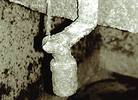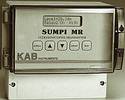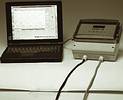
Modern, sophisticated ultrasonic level detection has come a long way since its humble beginning. Earlier instruments were fraught with many difficulties, resulting in many loosing faith in this technology. KAB Instruments saw the significant potential that existed and seized the opportunity. This South African company now offers a world-class product that fulfils its designed purpose, even in harsh operating environments.
Ultrasonic level detection
An acoustic pulse is emitted from the transducer towards the surface to be measured. This acoustic pulse is then reflected back towards the transducer and the time taken for the pulse to return is accurately measured by microprocessor-controlled circuitry. Knowing the speed of sound in air and allowing for ambient temperature, the microprocessor can mathematically determine the correct distance to within 1 mm.
The algorithms used in KAB's Sumpi series of ultrasonic level detectors have proven effective in preventing the instrument from locking on to any false echoes, guaranteeing valid level indication. The devices feature compensation for fluctuations in ambient temperature - and all instruments in the range are programmed via an integral keypad and LCD display, through a menu driven set-up procedure. Damping of the instrument is achieved through selecting a rate of change appropriate to the medium being measured versus the actual rate of change of the process.
While many other ultrasonic transducer manufacturers have difficulties dealing with dust coating on the transducer, KAB's unique self-cleaning system prevents a layer of material from accumulating on the face of the transducer. As shown in the photograph (Figure 1), while the outside case of the transducer is soiled with a considerable amount of build up, the active transducer face has been kept clean. Self-cleaning is accomplished by detecting any adhering material and repeatedly transmitting a very large acoustic pulse until the material drops off and the face is sufficiently clean.

Another important feature incorporated into the Sumpi range of level transmitters is the variable signal gain option. This enables the instrument to automatically adjust itself to allow for different working conditions. It does not matter whether the device is being used to measure off the smooth surface of a liquid, or off a rough, powdery surface, with clouds of dust suspended in the air. The instrument makes the necessary adjustment automatically, within seconds - so even if the conditions in the storage vessel are changing, the instrument will continue to give reliable readings.
The Sumpi's range of instruments comprises of the Sumpi (10 m range), the Sumpi-MR (30 m range - Figure 2) and the Sumpi-LR (60 m range). These instruments are suitable for solid and liquid applications, with the solid/liquid option being set via software.

Transducers and transmitters are offered as separate units, permitting the selection of the correct transducer for the application. Each instrument has a 32 digit alphanumeric display, an isolated 4 to 20 mA output, integral programming keypad and 2 programmable relays. All have a built in 21-point lineariser and a programmable multiplication variable for volumetric display. The Sumpi LR also offers a dual channel option and has five programmable relays.
Transmitters and transducers
Transducers are produced in different variants to match the transmitters to different application requirements. The KAB 10 is a general-purpose transducer that can measure up to 15 m on liquids and 5 m on solids. The KAB10F was specially designed to measure levels off solids and dusty material and can measure up to a range of 15 m. The F represents the foam that is used to acoustically match the transducer to the air, improving the efficiency of the transducer. The KAB 10 Teflon has been designed to measure liquids on difficult corrosive applications. There is a Teflon membrane on the face of the transducer to stop the corrosive material attacking the transducer. The KAB 20 is a medium-ranged transducer that can measure up to a range of 30 m, either liquids or solids. The KAB 20 has a Horn (focaliser), which narrows the beam angle. This ensures that there is no echo picked up from the side of a very narrow silo. The KAB 60 is a similar transducer to the KAB 20 but operates at a lower frequency - allowing the echo to travel further.
For short range, up to 5 m applications, there is the Shorti range. The entire Shorti range offers an integral transducer with LCD display and an integral programming keypad as standard. For use on solid or liquid applications, the Shorti PVC transmits a 4 to 20 mA signal; the Shorti SW features a configurable relay contact. Both are housed in aesthetically-pleasing PVC housings with the option of a PTFE transducer housing for aggressive medium applications and a foam-faced option for short-range solid applications. The power supply required is 220 or 110 V a.c. on the Shorti SW and 24 V d.c. on the Shorti PVC.
Configuration of the Shorti range of instruments is user-friendly with the setup of the instrument being menu-driven. The versatility of the range allows the engineer to select the type of instrument to suit his application. The engineer may select a transmitter, or a controller with the choice of chemical resistant material.
Open channel flow measurement
The Sumpi-FM has a range of up to 10 m, and 23 pre-programmed flumes and weirs, making this instrument well suited for many open-channel flow applications. Temperature compensation is included in the transducer, and accuracy is 0,25%. It has an isolated 4-20 mA output, 21-point lineariser, two programmable relays, a flow totaliser and a wide range of selectable engineering units.
Laptop computer
The computer age has made a significant impact on process control. The plant environment is now fully computerised from PLC to scada to the various bus systems on offer. KAB Instruments have seen the need for computerised set-up and diagnostic testing of its range of instrumentation. To make effective use of the increased measuring range and applications available, it is vital for the transmitter and transducer to be configured and set-up correctly.
KABScope was developed with this in mind. This software enables the user to view the bin map with an on-screen oscilloscope. This on-screen image can offer the user vital information so that the ultrasonic pulse can be maximised to gain the correct output signal for the specific application. Set-up changes can be made to the ultrasonic transmitter via the RS232 connection to the KABScope. KAB believes that this diagnostic software will be instrumental in removing the doubts of the past. These doubts originated before ultrasonic measurement technology had progressed to its current state of refinement.

A further benefit of using software to configure instrumentation is the service aspect. Accuracy of process measurement is vital. Although the KAB range of ultrasonic instruments is easy to configure, there are requirements for configuration assistance from the user.
Physical distance between the supplier and the user is no longer a problem. A case in point was an application problem on a plant in Brazil, where e-mail enabled KAB Instruments to solve the problem first hand. The application error was copied to KABScope, including the parameters, which were then e-mailed to KAB's offices. The necessary parameter changes were made in the KABScope setup utility which was then e-mailed back to the user who then downloaded the settings from his laptop onto the transmitter. The application continues to work.
Use of the software and information technology available enables ultrasonic technology to keep ahead of other forms of level measurement. "If one compares the cost versus the range of applications of ultrasonic instrumentation then the realisation is that ultrasonics will continue to dominate the level marketplace," says KAB.
In keeping with its expertise in the field of noncontact level control, KAB has also developed a microwave blocked chute and point level detector, the Switch. This features a 10 m range and adjustable sensitivity as well as time delay for damping. It is suitable for use in the harshest conditions. The microwave Switch transmits at 10,525 GHz (within the frequency range allowed by Post and Telecommunications) at 0,05 mW, which makes it completely safe, requiring no precautionary signs. The microwave signal exits the instrument through non-conductive 'windows' such as ceramic, brick, tile, PTFE, UHDP, rubber and glass. This means that dust will certainly not cause any measurement problems. The device has been used successfully for many years in the diamond, platinum, gold, coal and power industries.
Formed in 1987, KAB Instruments is one of the foremost instrument manufacturers in the South African market. The company specialises in the design and manufacture of ultrasonic level and flow instrumentation. Instruments are designed for use at high ambient temperature and in corrosive chemical applications. KAB Products are exported all over the world, with sales in 30 different countries.
KAB Instruments
(011) 435 5380

© Technews Publishing (Pty) Ltd | All Rights Reserved